
Nilphamari District is a district in Northern Bangladesh. It is a part of the Rangpur Division. It is about 400 kilometers to the northwest of the capital Dhaka. It has an area of 1,580.85 square kilometres (610.37 sq mi). Nilphamari is bounded by Rangpur and Lalmonirhat in east, Rangpur and Dinajpur in south, Dinajpur and Panchagarh in west, Cooch Behar of India in north. The headquarters are in Nilphamari, but the largest city is Saidpur.
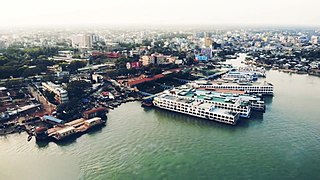
Barisal, officially known as Barishal, is a major city that lies on the banks of the Kirtankhola river in south-central Bangladesh. It is the largest city and the administrative headquarter of both Barisal District and Barisal Division. It is one of the oldest municipalities and river ports of the country. The city was once called the Venice of the East or the Venice of Bengal.

Somarama is one of the five Pancharama Kshetras that are sacred to the Hindu god Shiva. The temple is located in Bhimavaram of West Godavari district in the Indian state of Andhra Pradesh. It is one of the centrally protected monuments of national importance.
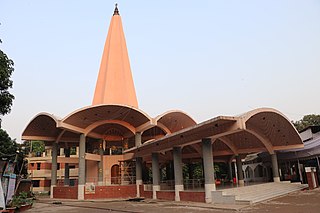
The Ramna Kali Mandir is a temple in Dhaka that was originally built in the time of the Mughal Empire. It was also known as the "Ramna Kalibari". The temple is dedicated to the Hindu Goddess Kali.

The Rudreswar Temple or Devaloya is a temple dedicated to Lord Shiva in the village of Rudreswar, under Sila Sindhurighopa Mouza, on northern bank of the river Brahmaputra, in North Guwahati. Built in 1749 CE by Ahom king Pramatta Singha, in memory of his father Swargadeo Rudra Singha, the temple is a fine example of a mixed style of Ahom-Mughal architecture.

Badarganj is an Upazila of Rangpur District in the Division of Rangpur, Bangladesh.
Badarganj is named after the mystic-saint Hazrat Badaruddin Shah. His tomb is situated in the middle of the town. After the conquests of Bengal, Turk Commander Ikhtiyar Uddin Muhammad bin Bakhtiyar Khilji stopped over at a field at Mansinghapur, Madai Khamar during his invasion of Tibet in 1203 AD to feed his horses. After that event, the field was named 'Bakhtiyar Danga'.
Bettadapura is a village located in Mysore district, in the Indian state of Karnataka. The name is derived from two Kannada words, "Betta" and "pura". Betta means "hill" and pura means "town". As per census survey of India 2011, the location code number assigned to Bettadapura is 618171.

Trikkur Mahadeva Temple is a rock-cut cave temple in Trikkur village in Thrissur District in Kerala believed to have been built in the 7th or 8th century. Being a cave temple, Buddhist and Jain monks used the site to meditate alongside the Hindu monks. It is a protected monument under the Department of Archaeology, Govt of Kerala since 1966. The temple and its premises are now owned by Paliyam Trust which is managed by Kshetra Samrakshana Samiti.

The Puthia Temple Complex consists of a cluster of notable old Hindu temples in Puthia Upazila, Rajshahi District, Bangladesh. Located 23 km to the east of Rajshahi city, it has the largest number of historic temples in Bangladesh. The temples were built by Hindu Zamindars Rajas of the Puthia Raj family who were noted philanthropists of Rajshahi. The temples have been built in terracotta in a variety of styles combining the typical Jor-bangla Style architecture with other influences. The Rajbari or Palace of the Raja of Puthia and the Dol Mancha are part of the complex. The temples are laid out around a lake named Shyam Sagar and the complex is surrounded by a moat called Shiv Sagar.

Bhoramdeo Temple is a Hindu temples dedicated to the god Shiva in Bhoramdeo, in the Indian state of Chhattisgarh. It comprises a group of four temples of which the earliest is a brick-temple. The main temple is the Bhoramdeo temple built in stone. The architectural features with erotic sculptures has given a distinct style akin to the Khajuraho temple and the Konark Sun Temple in Odisha, and hence the Bhoramdeo complex is known by the sobriquet the "Khajuraho of Chhattisgarh".
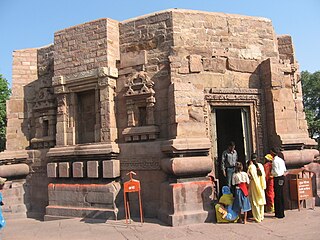
The Mundeshwari Devi Temple is a Hindu temple, located at Ramgarh Village, 608 feet (185 m) on the Mundeshwari Hills of Kaimur plateau near Son River, in the Bhojpuri region of Indian state of Bihar. It is an Archaeological Survey of India (ASI) protected monument since 1915. The ASI has dated the structure to 108 CE making it the oldest Hindu temple in the world.
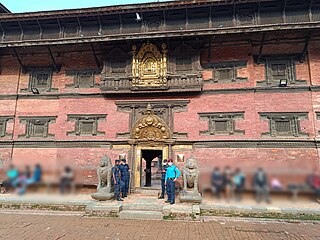
Patan Durbar Square is situated at the centre of the city of Lalitpur in Nepal. It is one of the three Durbar Squares in the Kathmandu Valley, all of which are UNESCO World Heritage Sites. One of its attractions is the medieval royal palace where the Malla Kings of Lalitpur resided.
Unlike some other religions, Hindus are not required to undertake pilgrimages during their lifetime. However, most Hindus go on such journeys to numerous iconic sites including those below:
The Muktagachha Shiva temple is a twin temple located outside the Rajbari of Muktagachha, located in the Mymensingh District of Bangladesh. The temple was constructed in 1820 by Rani Bimola Devi, the mother of Maharaja Shashikantha Acharya Choudhary, the Zamindar of Muktagachha. The twin temples consist of the Shree Shree Anandamoyi Shiva and Kali Mata Mandir. The Hindu Rabidas community performs a two-day-long Kattyani Puja, locally known as the 'Shat' Puja, in the Bengali month of Kartik. The temple is in dilapidated condition due to a lack of repairs.
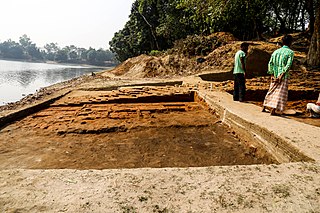
Bhitargarh is an archaeological site that includes the remains of an ancient fort city built in and around the 5th century AD. It is located in Panchagarh District in Rangpur Division in the northern part of Bangladesh and is large enough that it can be seen from space. The archaeological significance of the site lies in its strategic position as an intersection of the trade routes between Tibet, Nepal, Bhutan and the middle and lower Ganges Valley. At its height the city stretched over 5 km by 3 km and involved rerouting the Talma River.
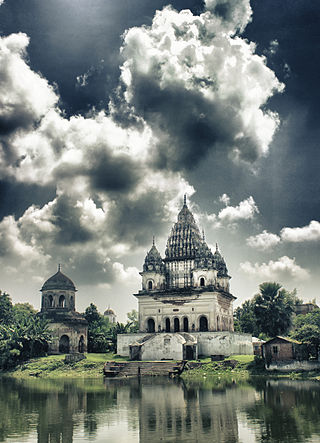
Pancha Ratna Shiva Temple, also known as Bhubaneswar Shiva Mandir, is a Hindu temple of the Puthia Temple Complex in Puthia Upazila, Rajshahi Division, Bangladesh. It is the largest Shiva temple in Bangladesh. The shrine overlooks the Shiv Sagar to its left. The temple is well decorated in pancharatna architectural style and is located at the entrance of the Puthia Rajbari. Among the surviving Hindu temples, this shrine is said to be "an exceptional and more attractive for its architectural beauty" in Bangladesh.
Lal Dighi is an area located in Chittagong, Bangladesh. Its location is at the end of Jail Road in the city. Lal Dighi is spread over an area of 2.70 acres. On one side of it is Andarkilla. Around it are district council buildings and local bank branches. It belongs to Ward No. 32 of Chittagong City Corporation.




















